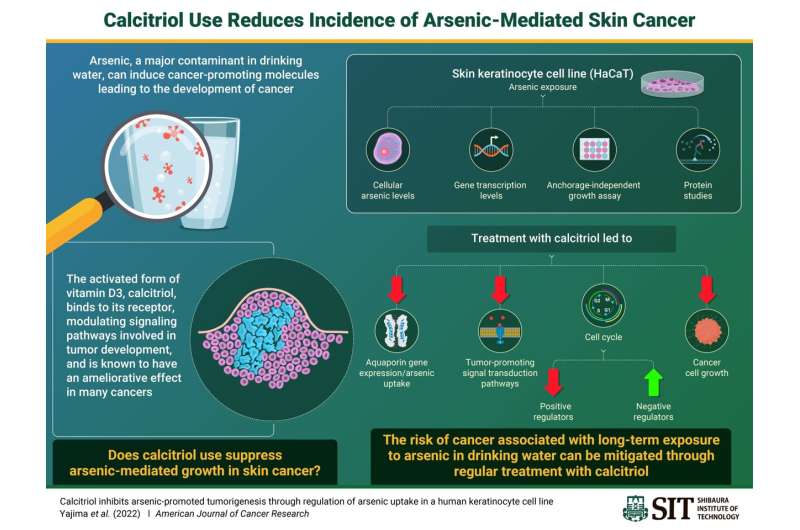Activated vitamin D3 treatment may reduce the risk of arsenic-mediated skin cancer

According to recent estimates, over 140 million people from 50 countries regularly get exposed to arsenic through drinking water. The exposure level significantly exceeds the guideline value (10 μg/L) stipulated by the World Health Organization. It is an established fact that chronic arsenic exposure from drinking water causes a variety of cancers including skin cancer.
Unfortunately, there is a general paucity of data on the underlying biological mechanisms that regulate arsenic-mediated carcinogenesis. Moreover, methods for the prevention and treatment of arsenic-mediated carcinogenesis have remained elusive thus far.
Researchers at the Shibaura Institute of Technology (SIT) and Nagoya University have recently been able to identify the underlying biological mechanisms of carcinogenesis inhibition. Using in vitro studies, the research team has been able to demonstrate how calcitriol, or activated vitamin D3, inhibits arsenic-mediated carcinogenesis in certain types of skin cells known as "keratinocytes."
These cells are primarily found in the epidermis, the outermost layer of the skin. It is a scientifically established fact that certain signaling molecules—kinase proteins (e.g., MEK or "AKT") that control the fate of various biological processes—are strongly associated with tumor development.
Professor Ichiro Yajima from the Unit of Molecular and Cellular Toxicology, Department of Bioscience and Engineering, SIT, who led the research team, says, "Our in vitro study in human nontumorigenic HaCaT skin keratinocytes showed that calcitriol, which is also known as activated vitamin D3 or 1,25-dihydroxy-vitamin D3, inhibited arsenic-mediated anchorage-independent growth with downregulations of cancer-related activation of several signaling pathways, including MEK, ERK1/2, and AKT, as well as activity of cell cycle."
To elucidate the relationship between arsenic uptake and calcitriol treatment, the researchers measured arsenic levels in HaCaT cells— long-lived, spontaneously immortalized human epidermal keratinocytes—treated with calcitriol using an inductively coupled plasma-mass spectrophotometer.
Quite interestingly, arsenic levels in HaCaT cells cultured with arsenic significantly decreased when these cells were treated with increasing doses of calcitriol. The findings from their study have been published in the American Journal of Cancer Research.
Dr. Masashi Kato, who serves as a Professor at the Department of Occupational and Environmental Health, Nagoya University, Japan, and is a collaborator on the study, adds, "Calcitriol significantly repressed arsenic uptake in HaCaT cells with the regulation of expressions of aquaporin genes (AQP7, 9, and 10), which were modified by arsenic exposure. Vitamin D receptor expression was significantly increased by arsenic exposure whereas calcitriol had no effect on the expression of the receptor."
The researchers then sought to understand whether calcitriol had an inhibitory effect on arsenic-induced tumorigenesis in cells other than skin keratinocytes. To this end, they performed anchorage-independent growth assays using a human normal lung epithelial cell line called "Beas-2b."
The results of these assays were equally astonishing: arsenic-mediated anchorage-independent growth of Beas-2b cells treated with calcitriol was suppressed by 21.4–70.0%, suggesting that calcitriol's potential to suppress arsenic-induced tumorigenesis is not restricted to keratinocytes.
Prof. Yajima says, "These results suggest that calcitriol suppresses arsenic-induced tumorigenesis not only in keratinocytes, but also in other target cells including lung epithelial cells. Furthermore, the expression pattern of aquaporin genes involved in arsenic uptake, a critical step in arsenic-induced carcinogenesis, is significantly altered by calcitriol treatment. We therefore believe that activated vitamin D3, or calcitriol, may contribute to the prevention and therapy for arsenic-mediated diseases including cancer."
Environmental toxins such as arsenic contribute significantly to the development of life-threatening diseases such as cancer. However, it may take years, even decades, for cancer to develop from drinking arsenic-contaminated water. The current research clearly indicates that calcitriol could be used as a test compound for validating the safety and efficacy of activated vitamin D3 and/or its analogs in preventing or treating arsenic-triggered cancer.
Taking vitamin D3 beforehand in arsenic-contaminated areas may reduce the risk of cancer development 5 or 10 years later and help people maintain good health for a long time. This is certainly welcome news for millions of people forced to survive on polluted water worldwide.
More information: Paper (PDF): Calcitriol inhibits arsenic-promoted tumorigenesis through regulation of arsenic-uptake in a human keratinocyte cell line


















